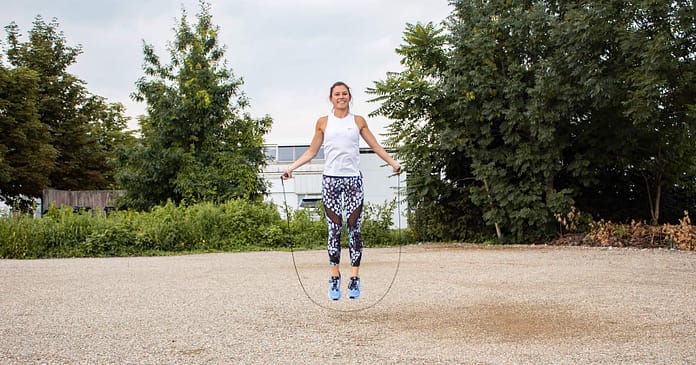Can you imagine a quick, effective and intense workout that will make you sweat after just a few minutes? Then try the jump rope!
Jumping rope of things for kids? Nonsense! It is so much more! With the skipping rope you get the best shape. You train your muscles, coordination, balance and endurance and also lose a few kilograms at the same time.
Jump rope is easy to learn and you can really train anywhere. And it’s fun too.
So grab the rope and let’s start the jump rope exercise.
You will find in this post
Why is jumping rope so healthy?
The skipping rope is used most often in fitness studios, in the garden, or at a home gym. no wonder! Rope jumping is a super strong endurance exercise that uses the whole body.
Similar to jogging, regular jump rope training helps strengthen your cardiovascular system and therefore your health. Just a few minutes of jumping rope a day will make your body fit and help you lose weight.
Ten minutes of jumping rope is as effective as jogging for 30 minutes.
Rope exercise is not only a great full-body exercise, but it also challenges the mind. In addition, she also trains strength, stability, sense of rhythm, and coordination.
And the best thing about jumping rope: it’s suitable for every fitness level! So it doesn’t matter if you are a beginner or a professional.
The more you swing the rope, the easier it will be. It is better to start on soft ground.
In addition, the higher the quality of the skipping rope, the easier it will be for you to spin.
What muscles are used when jumping rope?
Jump rope from strength sports. This means that you need to build and maintain strength for a longer period of time or for many repetitions.
When training with a jump rope, you use different muscles depending on the exercise and intensity. Mainly leg muscles. But depending on the exercises you choose, the core, chest and arms are also trained.
Here is a brief overview of the muscles that activate when jumping rope:
- vadenskill: This muscle is activated during push-ups and landings. It is responsible for bending the knee joint as well as for lowering and rotating the foot.
- Anterior thigh muscle: He is responsible for getting up from the squat. He also has to do a lot of work when cushioning and jumping.
- Straight abdomen: An important posture muscle that helps you balance while jumping.
- Rear extensors: Its function is to straighten the spine and keep the head upright, and it is also active when jumping rope.
- wrist: Rotational movements come when jumping rope from the wrists. This continuous movement involves 16 different muscles.
- bicepsYou need to bend and straighten your upper arms when jumping rope. So the muscles are under constant stress.
- Deltoid muscle: It is the largest muscle in the shoulder. It also experiences tension when jumping rope and ensures an upright posture.
However, jumping rope is not a suitable alternative to classic strength training.
If you want to build muscle during jumping rope, you should increase the load by using cuffs on the ankles or using special jump ropes with weights in the handles. However, this is more stressful for the joints.
If you want to train strength and endurance, you should combine jumping rope with exercises such as push-ups, strength exercises, sit-ups, and squats.
What you need to keep in mind when doing the jump rope exercise
Before you begin your jump rope workout, there are a few important things you should know. As with any other sport, there are a few things to consider to avoid injuries and get the best possible effect from your training.
Make sure you have enough space
Make sure there is enough space around you. Wipe off anything that may be bothering you and also make sure the ceiling is high enough.
Choose the right shoe
When jumping rope, it is important that you wear sturdy shoes. I prefer the ones with cushioning and a high shaft. In addition, you should not jump on a springy surface such as carpet or grass.
Warm up properly before jumping rope
As before any training, you should warm up properly before jumping the line. Especially the arms and ankles. Stand on your tiptoes a few times and then slowly lower your foot down. Circle your arms back and forth.
Use the correct skipping rope
There are a variety of skipping chords. But which one is better for you?
Light and thin plastic ropes are recommended for beginners. Advanced users can use ropes made of steel, copper wire, or leather. And for the pros, there are even jump ropes with built-in weights.
You should also make sure that the rope handle has a smooth ball bearing.
Regarding the length, you can use the armpit as a guide. To do this, stand in the middle of the rope. Feet about shoulder width apart. The ends of the rope should reach your armpits.
Pay attention to the correct basic method
Before you start exercising, you should know the basic technique first.
- Basically jump off the front foot and land softly without lifting your heels completely.
- Don’t jump too high. A few centimeters is enough.
- The legs are always slightly bent.
- Rope rotation comes from the wrists, not the arms.
- Keep your arms close to your body. The shoulders and forearms remain stiff.
- The gaze is directed straight ahead.
Beginners should focus on the basic jump first. If appropriate, other variations can be tried. Increase slowly and gradually without overdoing it.
Jumping rope: the 11 most effective exercises
Do you have everything you need to work out and want to finally get a sweat? Not a problem! Here are the best jump rope exercises.
1. A simple jump rope with a medium jump
- Jump over the rope with both feet at the same time.
- Before the rope advances again, you do a mean jump.
- Rotation comes from the wrists only, not the arms.
- The upper body is erect, the knees slightly bent.
2. Easy jump without intermediate jump
- In regular jumping rope, it is important that you do not jump too high.
- The rope comes into contact with the ground with each penetration.
- The upper body is erect and the arms are stretched.
- The angle between the humerus and forearm is more than 90 degrees.
- The knees are also slightly bent.
3. Jump rope workout: jumping from one leg
- Here you only jump with one leg.
- Pull the second leg back.
- Warning: tripping hazard! To avoid tripping, you have to take the rope away and make a big swing with it.
- The rope contacts the ground again with each penetration.
- The knee is slightly bent.
- The upper body is erect and the arms are stretched.
4. Running step as a jump rope exercise
- In this exercise, you can easily walk in place.
- The right and left feet alternately touch the ground, as when running.
- Swing the jump rope under your feet with each step.
5. Heel taps with skipping rope
- This exercise is similar to the running jump.
- You easily walk around.
- The left and right feet alternately touch the ground.
- Important: here you touch the floor with your heels.
6. Leap by step for more coordination
- With each jump you make a sliding movement.
- One leg extends forward and the other back.
- On the next jump, switch your legs. The front becomes the back and vice versa.
- The feet are always touching the ground at the same time.
7. Jump rope backwards
- Like Easy Jump, you jump with both feet at the same time.
- The rope swings back.
- Jumping without an intermediate jump.
8. Seilspringen Workout: Double lower back
- For this exercise, the rope under your feet should break twice with each jump.
- This is done on both legs.
- You have to jump a little higher and shift your wrists faster.
9. Jumping cranes
- With each jump, your feet alternately open and close. Like jumping.
- The upper body is erect.
- The arms are in the upper part of the body.
10. Criss Cross Arms
- beidbeinig spring.
- With each other jump, you contract your arms and jump over the rope.
- Loosen your arms. Jump normally and then cross again.
11. Legs crossed as a jump rope exercise
- In this exercise, you place your legs on top of each jump.
- First left foot forward. Then right.
- The upper body remains erect and the arms are lying flat.
- The rotation is done from the wrists.
How to lose weight with jumping rope
Rope training is definitely a great endurance training, as you can burn a lot.
However, the most important thing when losing weight is: You have to burn more calories than you take in. Movement is a major factor in this. But a healthy diet is more important.
Jumping rope can bring you closer to the look of your dreams. The exercise is intense. Your entire body is working and your heart rate is rapidly increasing.
Similar to HIIT exercise, you can increase your energy consumption within a very short time. So you can definitely add some variety to your workout with a jump rope and speed up weight loss.
Actual calorie consumption when jumping rope depends on several factors. Age, gender, weight, speed and body tension. In general, it can be said that jumping rope for 10 minutes burns 150 calories. For comparison: when jogging it’s about 350 calories per 30 minutes.
Warning: People who are very overweight should not use a jump rope. The jumps will put a lot of pressure on the joints.
Our conclusion
Rope jumping is an effective strength and endurance training that trains speed and jumping power as well as endurance and coordination. It’s a great addition to traditional strength training and perfect for warming up. Jumping rope increases your fitness, helps you lose weight, and is a lot of fun 🙂
To continue browsing:














